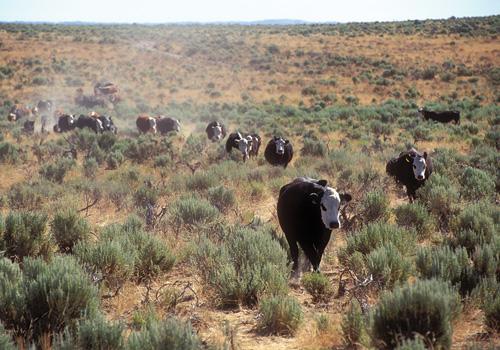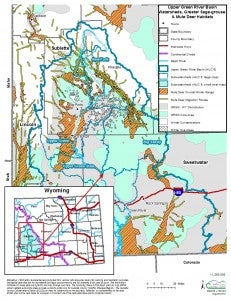Wyoming ranchers steward land, cattle and the greater sage-grouse

Ranchers and other private landowners have a critical role to play in conserving wildlife like the greater sage-grouse, which could face listing under the Endangered Species Act in 2015.
Home to nearly half of the greater sage-grouse’s remaining habitat, Wyoming is a landscape critical to the recovery of the species. A full 40 percent of the bird’s habitat in the state is privately held. Therefore, common sense solutions are needed to reward ranchers and other private landowners for conservation actions that protect vital habitat.
A rural, working landscape
Private lands in the West are often found near water, as ranches and other homesteaders put down stakes where they had ready access to water. For similar reasons, these areas are also critically important to wildlife.
A recent study from the Sage Grouse Initiative found a strong link between greater sage-grouse breeding areas, known as leks, and wet areas that serve as summer habitat for sage-grouse to raise their broods. The study also found that more than 80 percent of these essential wet habitats are located on private lands.
Fortunately, landowners in Wyoming and across the bird’s 11-state range recognize the central role they can play in recovering the sage-grouse. Their business, customs and culture are built on stewardship, so they were ready for the challenge.

Wyoming ranchers lead the way
A few years back, landowners in the Upper Green River Basin of Wyoming – an area located at the headwaters of the Colorado River, blessed with healthy streams and abundant wildlife habitat – started to look for new economic opportunities for conservation.
Alongside agriculture, the Upper Green also contains some of the most significant natural gas fields in the country (the Jonah Field and the Pinedale Anticline). Understanding that the sagebrush landscape of the Upper Green not only supports important habitat but also robust energy, tourism and agriculture economies, these landowners knew that conservation solutions needed to promote both economic development and healthy ecosystems.
Through the Sublette County Conservation District, the interest of ranchers and other local landowners evolved into a collaboration with the University of Wyoming, The Nature Conservancy and Environmental Defense Fund. Together, we’ve been exploring the potential for a market-based solution – the Upper Green River Conservation Exchange – that can sustain both the ranch and the important riparian and wildlife habitat located on these rural working lands.
With a listing decision for greater sage-grouse on the horizon, we are now working together to develop the tools and framework needed to get the exchange up and running as soon as possible.
Developing the tools for success
Recognizing the need to protect high-value habitat for the greater sage-grouse, the Conservation Exchange uses a set of tools to measure and quantify habitat, placing the highest value on healthy, unfragmented habitat. Energy companies and other developers that need to mitigate the unavoidable[1] impacts of their projects can use these values to calculate “debits” and purchase “credits,” which support projects that improve greater sage-grouse habitat. Landowners would be compensated by industry to offset their impacts and create additional benefit for the bird. It’s a win-win for people and sage-grouse – the economy and the environment.
As this effort has evolved and built up support from partners like Wyoming Association of Stock Growers and Wyoming Association of Conservation Districts, we are looking to expand the Conservation Exchange statewide. Happening simultaneously in other states are similar incentive-based efforts to protect the greater sage-grouse across its range and specifically on private lands. These exchanges work in concert with state and federal policies and other initiatives that protect and conserve sage-grouse habitat.
It’s this cooperation between parties that will ensure long-term prosperity of ranching communities and nature.
[1] Developers in Wyoming must follow the mitigation hierarchy established by the state’s Greater Sage-Grouse Core Area Strategy; in other words, after avoiding and minimizing impacts, they could use the Conservation Exchange to mitigate for any unavoidable impacts.












